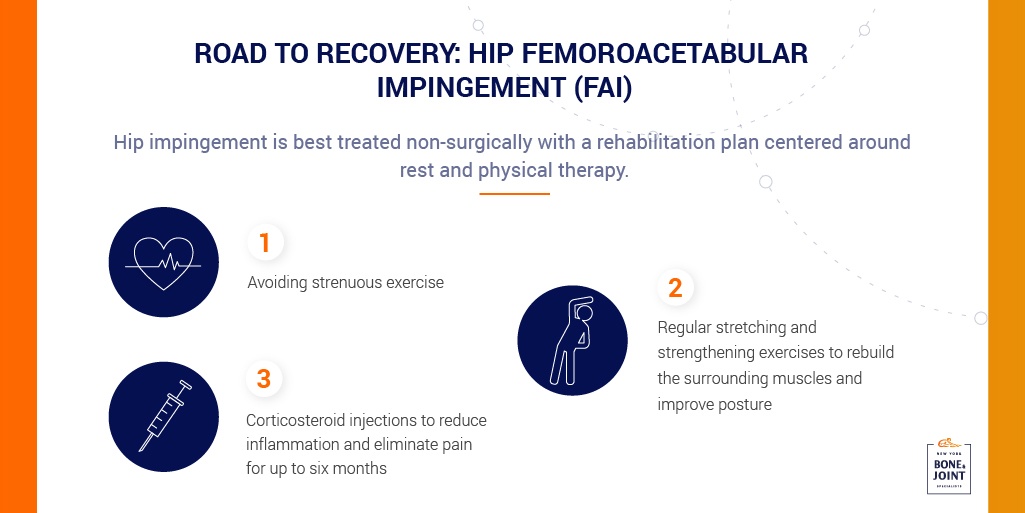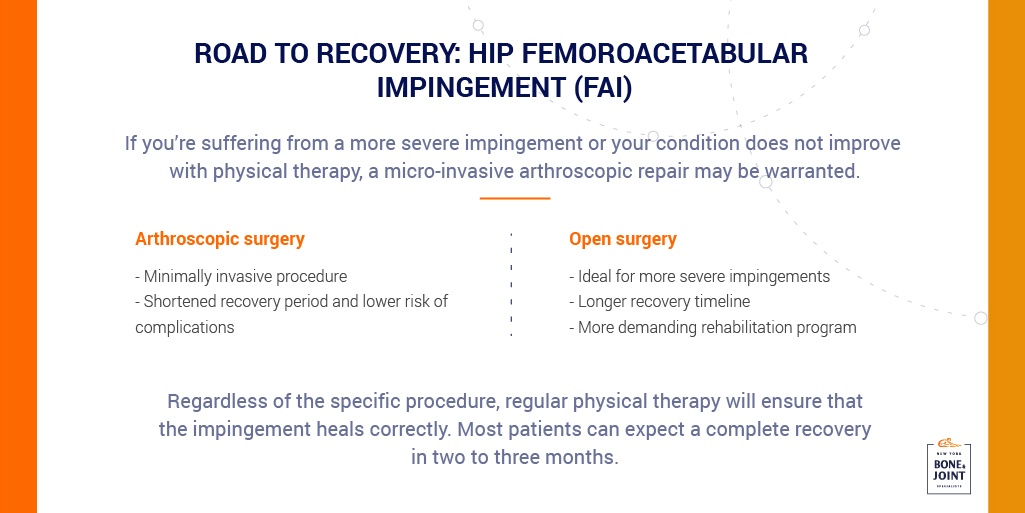HIP IMPINGEMENT TREATMENT WITHOUT SURGERY
At New York Bone and Joint, we strongly encourage our patients to consider non-surgical rehabilitation. While hip impingement can be surgically repaired, we’ve found that non-invasive treatments reduce the risk of complications while promoting quicker recovery, resulting in better long-term outcomes.
After your diagnosis, intense or prolonged physical activity should be avoided. A conservative course of treatment for hip impingement begins with physical therapy, which will help your body adjust to your hip abnormality and prevent future impingement. A physical therapist can evaluate your gait, range of motion, severity of pain, and the strength of surrounding muscles before devising an appropriate regimen of exercises. Most hip impingement exercises involve stretching, which makes the surrounding muscles and ligaments more flexible and thereby reduces contact with the bone. Other exercises focus on correcting your posture and gait, which can prevent limping, and strengthening the surrounding muscles, which can combat stiffening.
Physical therapy can be complemented with corticosteroid injections into the affected joint. The steroid will initially cause numbness in the area before reducing pain for up to six months, providing much needed relief for patients struggling with chronic pain.
HIP IMPINGEMENT SURGERY & RECOVERY TIME
In more severe cases, hip impingement may need to be repaired surgically. Fortunately, even serious impingements can be corrected arthroscopically, resulting in shorter recovery times and reducing the possibility of long-term complications.
During this procedure, your surgeon will make several small incisions into the skin surrounding the hip joint, inserting a camera through one of them to view the damaged hip while operating on it through another with small surgical instruments. After forming the incisions, your surgeon will remove damaged labral or articular cartilage from the joint and eliminate any bone spurs that caused the impingement. If necessary, your surgeon may also insert an anchor to tether the damaged labrum to the joint to ensure its stability.
After your procedure, your doctor will prescribe physical therapy to restore your natural range of motion, strengthen weakened muscles, and prevent the growth of scar tissue.
If bone spurs are causing the hip impingement, your surgeon might need to reshape the hip. Should this be necessary, your surgeon would most likely do so with an arthroscopic procedure, but the most severe hip impingements may need to be corrected with an open procedure such as hip resurfacing or a partial or total hip joint replacement. In each case, your surgeon will remove a portion or all of the inner socket and femoral head and replace them with a metal and plastic prosthesis designed to mimic the gliding movement of a natural joint.
As with less invasive procedures, physical therapy will be needed to ensure complete recovery. Your therapist will begin treatment by manually stretching your joint to prevent stiffness and preserve your range of motion. Then, you will do exercises that help you recover your normal gait.
Eventually, you’ll also work on rebuilding the muscles in your legs and core so that they can better support the artificial joint. Throughout the process, your surgeon will schedule regular followup appointments to confirm that your recovery is proceeding smoothly.
_________________________________
EXPERIENCING PAIN? DO YOU HAVE AN INJURY?
Our Specialists are here to help.
Book an appointment with NYC’s best orthopedic specialists to discuss your condition. Fill out the form below and you will receive a call from our office within 5-10 minutes. We’ll book an appointment at a time and location that work for you, and send you a reminder by email.











